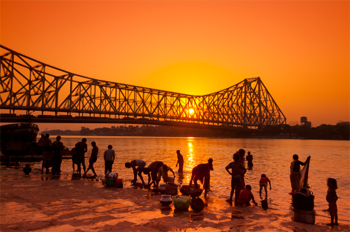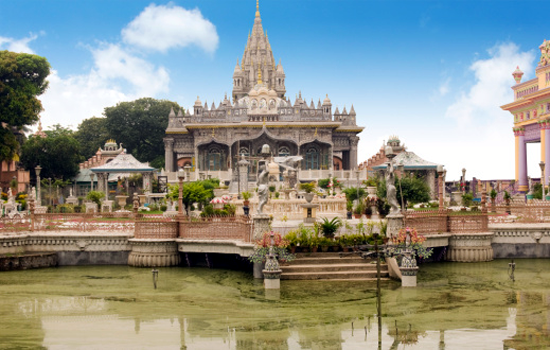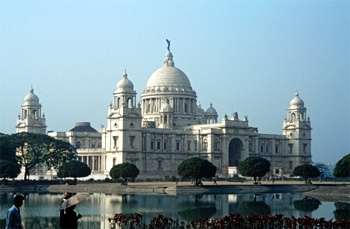Dec 23, 2025
Dec 23, 2025
 Once declared as a dead city. Kolkata is on her way to regain her past glory. Overburdened by refugee and unemployment problem that made the city out of the gear and devastated by labour problems Kolkata once panted helplessly. But that is past and city may emerge as a great economy if it’s potential is capitalised. A visit to Kolkata is indeed a lifetime experience.
Once declared as a dead city. Kolkata is on her way to regain her past glory. Overburdened by refugee and unemployment problem that made the city out of the gear and devastated by labour problems Kolkata once panted helplessly. But that is past and city may emerge as a great economy if it’s potential is capitalised. A visit to Kolkata is indeed a lifetime experience.
To the British, Calcutta was their jewel in the crown. But till recently shunned as an economic backwater by the investers, the present Kolkata is fortunately witnessing a giant metamorphosis. On my recent visit to Kolkata I was heartened to find the broad roads, high-rises, abundances of setus or bridges and glittering malls. The city regained confidence of a glorified past that was withdrawn for years and the state is becoming the chief food bowl of India. The surprisingly clean roads, and the smiling faces charm the tourists who throng to visit this culture capital of the country. It is after all the City of Joy. Unlike in other cities where the crowds gate crash to watch the fashion shows, vulgar films and ramps, this city’s intellectuals, litterateurs, poets, classical singers, classical dancers and conventional artists still draw crowd. A civilization is dead if she can’t honour its intellectuals and promote vulgar culture and in Kolkata culture exists in its refined form.

It is a city that is an interesting combination of the east and the west, a fusion of modern and ancient. The lazy Ganges (or it is Hoogly?) passes in Dakshineshwar reminding all of us the great saint Ramakrishna Paramhansa’s philosophy of Jata mat tata path. How relevant are his words today in a violence-torn earth! On a moonlit night near the banks of the river Ganges the samadhi of Ramakrishna Paramhansa, Sharada Devi, Swami Vivekananda and Swami Brahmananda at Belur Math (founded by Swami Vivekanada) are overburdened by the flowers of the devotees while nearby in the garden Bengal dahlias are in their blooming best.
A journey from Garia hat to Srirampur was fascninating. I crossed through glittering Esplanade, (the passion of Bengalis, the heartthrob of writers, intellectuals, businessmen, Marwaris and still lights passion in every tourist who throng the city).  The Victoria Memorial was sparkling in green light when the fountains were in their magical best. The chirping of birds retiring for nests was overshadowed by carols from the Cathedral Church close by. In the cemeteries World War II soldiers and Anglo-Indians sigh. “Alas! Such beauty-no more belong to us!” While returning at midnight through the bridge over the river Ganges one could see once again the moon over the Dakshineswar where once again sparkling green lights lit the ethereal river and the sky. Kolkata is indeed beautiful at night. In the vast expanse of the river the boatmen still take passengers to their individual destinations. In Birla Planetarium the enthusiastic cosmos watchers are looking at the virtual space. Both vast expanse of nature along with technology have opened her way to post modern.
The Victoria Memorial was sparkling in green light when the fountains were in their magical best. The chirping of birds retiring for nests was overshadowed by carols from the Cathedral Church close by. In the cemeteries World War II soldiers and Anglo-Indians sigh. “Alas! Such beauty-no more belong to us!” While returning at midnight through the bridge over the river Ganges one could see once again the moon over the Dakshineswar where once again sparkling green lights lit the ethereal river and the sky. Kolkata is indeed beautiful at night. In the vast expanse of the river the boatmen still take passengers to their individual destinations. In Birla Planetarium the enthusiastic cosmos watchers are looking at the virtual space. Both vast expanse of nature along with technology have opened her way to post modern.
The city is the book lover’s paradise. Within his limited resources the enthusiastic father is purchasing books for tiny tots. Boi Mela’s popularity is next to enthusiasm of Durga Puja. Science City is one of the best centres providing scientific information in the country. Blasted with information in a knowledge based economy, the city could transform into IT superpower. Once the so called communists had said “If you can do business with China, why not with West Bengal?” In this once communist state, Goddess Durga hopes to bring every year joy and prosperity. Blue prints of setting up of two hypermarkets were ready. Global IT companies such as IBM, Cognizant, Sky tech and Indian giants - Wipro and Satyam were heading towards Calcutta Oh! Kolkata at the time of my visit. Tourists board the air-conditioned delux buses to reach Tagore’s Shanitiniketan, Digha, Diamond Harbour, Sunderban, Ramakrishna Paramhansa’s native village Kamarpukur and Sharada Ma’s house in Jai Ram Bati. Technology, communist ideology, dialectic materialism, nature and devotion held their hands. It is a city that everyone envies, it is a city that is admired by everyone even by its enemies.
This is a city which is Senior Citizen’s paradise. This is a city which is creative people’s paradise. Youngsters, the representatives of modern generation’s purchasing power have accelerated and every week they visit Pantaloons (being most popular) and Westside for their share of shopping, bargaining and eating still on holidays they learn Tagore songs and participate in painting competitions. Bengalis are famous(or notorious) as lovers of food. But now the working women throng Park Street restaurants and the Salt Lake City markets with great enthusiasm, and the Bengali babus don’t mind to receive the packaged tuna fish( as opposed to steamed hilsa fish from mother’s kitchens) from the working wife’s manicured hands. Indeed a giant metamorphosis!
I, belonging to an ancient generation visited Victoria Memorial and wonderful museum to pass through the three hundred years of Bengal’s history, watched original paintings by Bengal masters and paid homage to Nataraja, the Cosmic dancer, a 13th century Chola Bronze dancing anandatandavam among other statues accumulaing dust. How can a city die when Goddess Kali protects her and Mother Teresa choses her adjacent territory to construct Nirmal Hriday? How every Indian Nobel laureate is connected to this city in some or other ways? Tagore, Mother Teresa, Amartya Sen or C.V Raman or the Internationally renowed film- maker Satyajit Roy had kissed the earth of this city! From Rabindrannath Tagore to Mother Teresa, from Raja Ram Mohan Roy to Netaji and Nivedita, from Swami Swami Vivekanada to J.C. Bose walked down through the streets of this dynamic city. How can the city of goddess Kali who Herself is the epitome of Shakti and personifies, Kal or time principle suffer the inevitable destiny, the end of time?
26-Jun-2012
More by : Mandira Ghosh

|
Would like to find out what else you could tell me about Finnac's, as I am compiling my grandsfather's life. Would you have a recent picture of where the shop Finnac's once stood? |

|
Enjoyed reading and Calcutta should regain all the glories ... no harm even if it is at a slow pace! |

|
What struck me about Calcutta, as an Anglo-Indian boy down from Darjeeling boarding school for three months each year in the fifties, was its modernity, its ever increasing modernity. Even then, it had its chic restaurants and cinema houses showing all the latest Hollywood films, the naya bazaar ( Sir Stuart Hogg market) and its high quality shops, its excellent tailors, Finnacs on Park Street and Phelps, which had the contract for school uniforms; and in the music department one could buy the best hi-fi equipment and immediately access the latest hits of Elvis Presley, Cliff Richard et al from record shops. I recall the hula-hoop craze just as it emerged overseas! We had no TV then, but it was to come. Calcutta was on the travelling wave of modern westernised culture; modernised transport, both private cars and public conveyances, the building of the Calcutta Metro (underground railway); the Park Street flyover, and the new Howrah Bridge. I left Calcutta in 1962, to easily slot into London society, where, despite the differences - the equality in the UK of all citizens in terms of basic earning power and standard of living, a real culture shock - there was the same basic feel for modernity that informed life and the future one aspired to. Unfortunately, or fortunately, Indian, even Bengali culture, as a force in modern Calcutta, was anachronistic in this context: or maybe, it was just one facet of experience, that of being Anglo-Indian, but which, as mentioned, seemed to be in sync with the Calcutta of the day. |

|
Yes, The city of joy can be a place of divine where people are ever green and fruitfull to the thought of love and passion for humanity and kindness.Love grows forever, where the language Bangla sounds like necter, where every human speaks poetry and arts. It is a Gods own city where people are born to live together with love and compassion. Let it long live 'Oh Kolkata,' Let it prosper 'Oh Kolkata,' |

|
CALCUTTA FOREVER She is not quite dead nor dying This multitudinous lady She is living And forever will she live. Her house is no more a home Where life may thrive It is falling apart Brick by brick At the gate Her son a pimp Starving and stark naked Sells her daily Freely in Free School Street Yet she thrives in another place Where her other sons colonize. Overlooking the Museum The Maidan is maddeningly green Now with patches of grey On this chessboard like pawns Her sons play A game with death In the dead of night With balls of lead shot from behind. They embrace death defying death And their young blood Seeps into the soil long dry To regenerate the Maidan into an evergreen. Her pock-marked pavements A perennial fight Against the highways of life Are claimed by a tide Surging from a primeval source, After a long drift It strikes its deathless roots In every nook and garbage heaps While parasites take their flight Into the multistoried sky Or burn themselves insect-like In Park Street’s purple lights. The great bridge is astride two worlds -- One rising while the other subsides. The swelling multitude nakedly multiplies Under naked lamp-post lights Seeking its primal roots In deposits of time When those three sleepy villages Agelessly dreamt Rocked by timeless lullabies and rhythms Of cycling life---- A mammoth anachronism Her accretions of time Collapse in on themselves In dust and debris and lime. ------------------- |